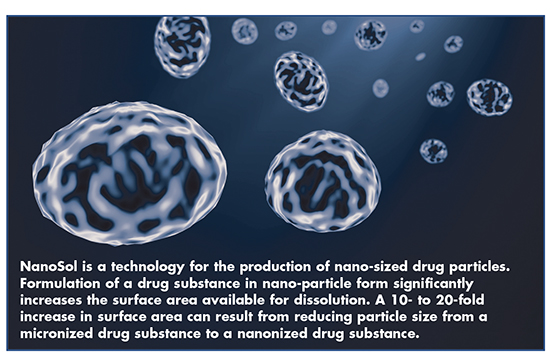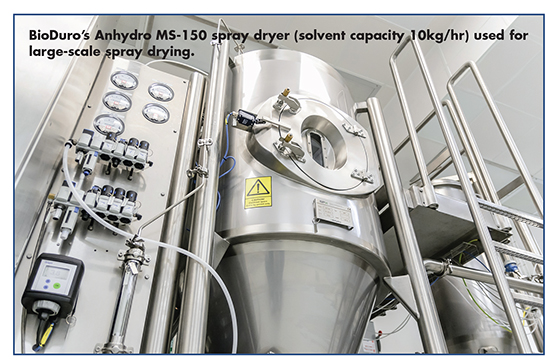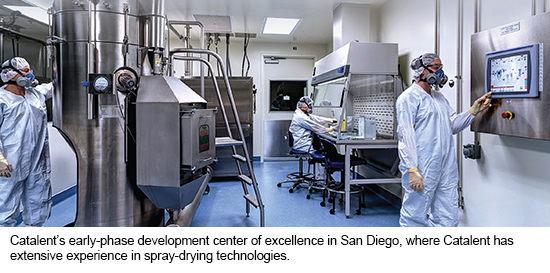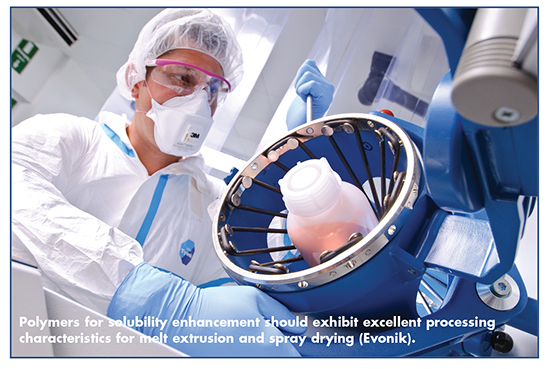Issue:March 2019
SPECIAL FEATURE - Improving Bioavailability & Solubility: Chemical & Physical Modification vs. Formulation Development
Sufficient drug solubility behavior remains one of the most challenging aspects in formulation development. Adding to this challenge is that there are even greater time demands being placed on drug development as the market becomes even more competitive. Some developers point to chemical and physical modifications for improving bioavailability/solubility while others claim formulation and delivery methods are effective.
“Physical and chemical modifications allow for thermodynamic stability of the system, allowing for not only maximum shelf life, but also practical dosage forms like tablets and capsules,” says Dr. Frank Romanski, Global Technical Marketing Manager, BASF Pharma Solutions. “The chance to improve solubility of a drug by chemical modification is usually limited to the very early stages of development,” counters Dr. Jessica Mueller-Albers, Strategic Marketing Director for Oral Drug Delivery Solutions at Evonik. “Chemical modifications, such as varying the salt being used, may also change your pharmacokinetics and pharmacodynamics. That is why there are few instances where this method alone has been successfully applied to improve drug solubility.”
As a result, there have been innovations in formulation development that create a variety of options to enhance solubility and optimize physiological absorption. “Since there won’t be any impact on the pharmacological behavior of the drug, this pathway provides more freedom and a higher probability of success,” says Dr. Mueller-Albers. Physical modifications and formulation are closely related to each other, and can have a significant impact in retaining bioavailability over time. Because this interplay will have a decisive role for all downstreaming processes, it is the key to attaining drug product stability.”
In this annual Drug Development & Delivery report, this debate between approaches to solubility enhancement is further explored. Additionally, scientists discuss new technologies and techniques, such as modelling, for improving bioavailability and solubility.
ABITEC: Combining Physical & Formulation Strategies May Be Best for Improving Bioavailability
It is believed that 40%-70% of new chemical entities (NCEs) face bioavailability challenges. In addition, companies developing new biological entities (NBEs) for oral delivery encounter similar challenges. Consequently, formulators regularly explore various approaches to improve an API’s pharmacokinetics such as physical/chemical modifications or formulation strategies.
Physical and chemical modifications aim to improve bioavailability by increasing drug solubility. Techniques like nanomilling, spray drying, and micronization reduce particle size and increase surface area-to-volume ratio, which encourages interaction with the solvent. Dr. Heath Bowers, Technical Business Director Pharmaceuticals at ABITEC explains that mechanical manipulations produce heat and can lead to degradation of an NCE. API salification and co-crystallization offers a stable solid form with increased solubility. Nonetheless, charged ions can encourage hydration or polymorphism, resulting in variability of the drug’s performance. “Amorphous solid dispersions create non-ordered particles that easily dissolve in solution. However, the drug’s amorphous nature can be unstable, converting to a crystal during storage.”
On the other hand, formulation strategies can increase API solubility as well as permeation, depending on the excipients utilized. Functional lipids are a versatile tool for formulators and offer delivery strategies like self-emulsifying drug delivery systems (SEDDS) and lipid nanoparticles (LNPs). Nanoemulsions (SEDDS, SMEDDS, SNEDDS) were developed to provide improved bioavailability, reproducibility, and enhanced API permeation. Dr. Bowers says that despite broad potential, most emulsion systems in approved drugs are dosed either as a parenteral or soft gelatin capsule due to the liquid nature of nanoemulsions. LNPs like Solid Lipid Nanoparticles (SLNs) and Nanostructured Lipid Carriers (NLCs) circumvent these limitations by utilizing long chain glycerides, which provide a solid lipophilic matrix. LNPs increase drug encapsulation, stability, and can be incorporated into tablets. LNP properties can lead to toxicology and drug expulsion challenges though, so proper studies must be conducted.
“While physical and formulation strategies can individually increase bioavailability of molecules, a combinatorial approach may be the best. A SEDDS formulation that solubilizes a salified API created with a lipophilic salt is a perfect example. This combinatorial approach has demonstrated better drug loading and pharmacokinetic profiles then SEDDS alone. In the end, there is no wrong answer if the desired therapeutic response is delivered,” Dr. Bowers says.
Ascendia Pharma: A Suite of Technologies Address Challenging Compounds
There are several methods available for solubility and dissolution enhancement of poorly water-soluble drugs. From Ascendia’s perspective, nanotechnology is driving the solution for these difficult formulation challenges, providing new options for pharmaceutical products to be developed with improved biopharmaceutical properties.
“We are helping to overcome bioavailability and solubility issues with a suite of three technologies – AmorSol, EmulSol, and NanoSol,” says Jim Huang, PhD, CEO, Ascendia Pharmaceuticals. “These advanced approaches allow us to meet stringent timelines and solve difficult challenges with compounds. Offering three technologies allows Ascendia Pharma to address these compounds more efficiently, especially those with the most challenging chemical properties.”

Ascendia also utilizes lipid nanoparticles (LNP) in its technologies to improve biosolubility and achieve more effective sustained-release properties to enable better dosage of active ingredients in patients, adds Dr. Huang.
Regarding the issue of using formulation or physical modifications, he says that such modifications can change solubility and enhance bioavailability, but a new chemical entity may be formed. If this occurs, additional toxicity studying must be conducted, which will add time and money to the development phase. Dr. Huang says: “Our technologies use current pharmaceutical science formulation approaches to improve solubility and bioavailability. This creates significant market value because our scientists don’t have to worry about physical modification of the chemical through the process. The benefit is that we can bring the drug to market with much less investment and in a shorter time, creating significant value.”
As an example, Dr. Huang points to ASD-005, a weakly basic cardiovascular drug with low solubility in aqueous media. Currently, it is only available as an oral dosage form. Ascendia developed an injectable nanoparticle formulation for use in an acute care setting. “Our scientists stabilized the drug substance in nanoparticle form using lipid excipients to enhance the drug loading and to achieve sustained release in vivo.”
The process that Ascendia developed involves the homogenous mixture of drug and lipids, then nanosizing the mixture in a parenteral grade vehicle. Prototype formulations were prepared with an average particle size of less than 100nm. A sustained-release PK profile with an enhanced bioavailability was achieved in an animal study over a 24-hour period after IV injection of the nanoparticle formulation. The control, a solvent-based solution, was rapidly cleared out of the body within a few hours.
BASF Pharma Solutions: Responding to the Shift in Solubilization Techniques
“Formulations and formulators worldwide are shifting their focus to solubilization techniques and formulations that are highly practical,” says Dr. Frank Romanski, Global Technical Marketing Manager, BASF Pharma Solutions. “Years ago, many formulations focused on nano-based methods of producing semi-stable suspensions and dispersions, requiring high quantities of solution or powder, impractically low concentrations of drugs, and multiple doses per patient per day. In 2019, this has shifted to using techniques like amorphous solid dispersions (ASDs) where 50%+ API is solubilized in a polymer matrix, and further processed into common tablets – clearly a practical solution.” Others work with lipid systems, like self-emulsifying drug delivery systems (SEDDS), which are easily encapsulated into soft or hard capsules for practical patient use.

Another shift he notes is from a batch-centric, highly specialized way of formulating to a strong focus on the overall processing. “For example, ASD formulation through extrusion can be easily used as a bolt-on technology for continuous manufacturing, as the system functions essentially as powder-in and powder-out. With the rest of the pharma industry looking into continuous manufacturing, techniques that work within this approach will continue to grow in use.”
BASF’s specialization is in three core areas: amorphous solid dispersions (ASDs), lipid-based drug delivery systems (LBDDS), and liquid solutions. Liquid solutions, typically used in oral liquids and parenteral formulations are the simplest, where API is solubilized within high surfactant containing systems that solubilize the drug in colloidal structures like micelles for effective delivery via parenteral routes. Excipients used must have low immunogenicity, given the high concentrations required. BASF’s Kolliphor® HS 15 is an example. This surfactant contains many potent solubilizing characteristics of non-ionic ethoxylated surfactants, but exhibits a minimal immune response upon administration.
ASDs are a highly effective method of formulating poorly water-soluble drugs and developing them further into solid oral dosage forms. Using Hot Melt Extrusion (HME) or spray drying, the drug is solubilized into a polymeric matrix, such as Kollidon® VA 64 (copovidone). This highly effective strategy produces powder of ASD with high (upwards of 50%) API content that can be readily processed into tablets.
Finally, LBDDS, and more specifically, self-emulsifying drug delivery systems (SEDDS) are a highly effective, commercially accepted method for formulating poorly water-soluble drugs. Through careful formulation, a microemulsion is formed with oil, water, and surfactant, which becomes a clear, low viscosity solution, ready for encapsulation into a soft or hard gel capsule.
Two BASF molecules, Kolliphor® HS 15 and Soluplus®, can be used to formulate a multitude of formulations with improvements in drug solubility and subsequent bioavailability. Both were recently approved in commercial formulations, Soluplus in the EU and Kolliphor HS 15 in the US.
BioDuro LLC: Enabled Formulations Bridge Discovery & Development
Success of an insoluble API depends on swift assessment of solubility challenges and rapid development of an enabling formulation to accelerate drug discovery and development timelines. There are ways to counter an insoluble API problem by using chemical or physical modifications.
“Chemical modifications are very useful in molecules that can be converted to a salt form or a pro-drug, but not all molecules are amenable to chemical changes,” says Ruchit Trivedi, Associate Director of Formulation, BioDuro LLC. “In those molecules that can be modified, chemical change can result in loss of activity. In such situations, it is necessary to pursue physical modifications of the molecule to improve kinetic solubility of the API.”
Amorphous dispersions – amorphous API in a polymer matrix – provide a sophisticated solution to solubility issues, says Dr. Trivedi. Conversion of crystalline API to amorphous form can increase the API’s kinetic solubility. Limited API availability during drug discovery reduces the extent of amorphous dispersion evaluation during discovery phase. “Micro-evaporative dispersions present an innovative and efficient solution to overcoming low API solubility during drug discovery and lead optimization,” he says. “With micro-evaporative dispersions, <1g of API is needed to evaluate several amorphous dispersion matrices. This can then be leveraged into downstream development or used for early pharmacokinetics studies to quickly eliminate potentially unsuccessful APIs during early discovery.”

BioDuro has developed the BioDuro Solution Engine that utilizes micro-evaporative dispersions in a streamlined process to screen an API with multiple polymers for solubility enhancement. Dr. Trivedi says this saves time during the development process and allows for rapid development and generation of sufficient material for in vivo screening of amorphous dispersions, thereby increasing reliability of the process.
He says: “We have have successfully applied the micro-evaporative process to selection of matrices that provide enhanced solubility as well as controlled release functionality,” he says. “By utilizing API information from clients, knowledge gained through micro-evaporative dispersions, and in vivo expertise of our DMPK partners, the BioDuro Solution Engine can bridge the gap between discovery and development through rapid identification, development, and scale up of formulations.”
Lipid-based drug delivery systems, amorphous dispersions, particle-size reduction, and salts continue to be the gold standards for improving solubility of a drug molecule. “New excipients provide an opportunity to extend the functionality of current solubility-enhancing technologies,” says Ronak Savla, PhD, Scientific Affairs Manager, Catalent Pharma Solutions. “It is important that these new technologies address some of the shortcomings of current technologies if they are to reach commercial scale.”
Dr. Savla points to two major trends in the changing landscape of pharmaceutical development: increasing the percentage of drugs indicated for smaller patient populations; and more candidates from start-up companies accounting for a larger share of the pipeline. In both instances, the volume of API needed or available is limited compared to drugs developed by big pharma and for highly prevalent diseases. “Many of our sites have employed material-sparing techniques to consume less API and use new strategies and technologies to extrapolate results and speed up development,” he says. “We also employ in silico prediction software to calculate the physicochemical characteristics of a molecule, which reduces the number of lab experiments.”

Recently, the Developability Classification System (DCS) was refined to be more applicable for early development when the drug dose may be unknown. Catalent utilizes physiologically-based pharmacokinetic (PBPK) modeling to uncover various factors that lead to poor bioavailability and solubility.
“It is not uncommon that drug developers realize that they have a bioavailability issue only after completing animal PK studies,” says Dr. Savla. “There is often a lack of data to elucidate the reason(s) for poor bioavailability. We want to understand if poor bioavailability is due to poor solubility, low fraction absorption, high first pass metabolism, rapid clearance, or a combination of these and other factors.”
The first step, he says, is to fill in the missing data on the API’s physicochemical characteristics: solubility in media and biorelevant buffers, crystallinity, purity, particle size and morphology. Poor solubility can be addressed with salt formation, formulation, and chemical modification. High first pass metabolism and rapid clearance can be addressed with higher and more frequent doses, but chemical redesign may be necessary.
Evonik: Bringing Together Material Engineering & Formulation Development
With more than 90% of actives currently in development considered to be poorly soluble or permeable, Evonik is seeing more customer projects for drugs with higher molecular weights and increased lipophilicity. “These customers will have often encountered challenges with basic technologies such as micronization and salt formation during the development of their early formulation concepts, says Dr. Jessica Mueller-Albers, Strategic Marketing Director for Oral Drug Delivery Solutions at Evonik. “Because these techniques are limited by the nature of the API, they can only influence the solubility rate and not the apparent solubility of the compound itself.”
As a specialist in advanced drug delivery, Evonik brings together material engineering and formulation development competencies, such as particle engineering, solid dispersions, and silica technologies to address poor permeability and optimize bioavailability.

For example, EUDRAGIT® polymers can dissolve APIs at the molecular level for stable, solid solutions, and have excellent processing characteristic, she says. “For spray drying, they are lightly soluble in common solvents and show excellent powder compressibility. For hot melt extrusion, they have excellent thermoplastic properties and broad miscibility with APIs and other excipients.”
She also recommends combining predictive tools like MemFis® for melt extrusion and formulation modeling to minimize development costs, as well as the early identification of suitable process technologies and formulation ingredients that can improve drug loadings and stability.
With an increasing number of poorly soluble compounds existing in the pre-clinical stage of development, Evonik has identified significant customer demand for rapid entry into clinical Phase I trials. For classical Phase I clinical trials, a fit-for-purpose formulation is required. However, for poorly soluble drugs, a conventional fit-for-purpose formulation is typically not possible. Therefore, Evonik has created a program for complex dosage forms that identifies the most appropriate technology for the customer’s API based upon a series of factors.
Lonza Pharma & Biotech: HPMC Capsules Provide Bioavailability Enhancement
Pharmaceutical companies are increasingly exploring and developing drugs with molecules that have solubility and/or bioavailability challenges. One way for drug developers to address these challenges is with functional capsules with physical and operational features. For example, a range of capsules exists that allow for either immediate release or controlled release of drugs for targeted delivery, or that provide enteric protection so the dosage form does not require additional coating. Both of these attributes enhance the functionality of formulations and protect them so that the optimal product reaches the patient. Capsules that impart these benefits act as functional excipients to enhance formulation efficacy.
Hypromellose (HPMC) capsules are an example of specialty polymers that can aid in bioavailability enhancement. HPMC capsules containing no gelling systems are similar to gelatin capsules – dissolving quickly and predictably at different pH levels and dissolution media compositions – but also offer a lower moisture content than gelatin capsules, making them more suitable for hygroscopic and moisture-sensitive drugs and manufacturing processes, says Matt Richardson, PhD, Manager, Pharmaceutical Business Development, Lonza Pharma & Biotech Capsule Delivery Solutions.

“Internal and external studies have shown that HPMC capsules can also provide increased bioavailability for some classes of molecules by sustaining supersaturated concentrations of dissolved drug in the gastrointestinal tract via crystallization inhibition,” he explains. “This is especially advantageous for drug forms such as high-energy salts and amorphous drug forms, as well as weakly basic drugs that are capable of supersaturating in the GI tract. HPMC capsules can also be specifically designed to be paired with enabling technologies like hot melt extrusion, furthering their potential for bioavailability enhancement.”
Capsugel® Vcaps® Plus capsules, from Lonza, are HPMC capsules that are suitable for moisture-sensitive ingredients, helping limit potential transfer of moisture exposure to API and working to enhance stability, Dr. Richardson says.
Particle Sciences: Examining Bioavailability & Solubility Innovation From an Advanced Formulation Perspective
Pharmaceutical scientists are always looking for ways to solve bioavailability and solubility issues related to delivering therapeutic payloads on target, on dose, and on schedule. Within the bounds of oral-solid dose forms, bioavailability and solubility issues are still resolved through a tried and tested set of formulation tools.
“However, although oral delivery for a broad range of APIs is well anticipated by popular non-proprietary methodologies, standard off-the-shelf solutions may not be enough for more challenging APIs,” says Robert Lee, PhD, President, Particle Sciences. “Without exploring alternative, more specialized formulation techniques, these actives may not progress through the development pipeline.”
Finding an effective method to dose more complex molecules may be less straightforward, but techniques do exist to successfully incorporate these actives into viable drug products. It is important to assess a range of technologies, ideally orthogonal, to address the molecule-specific challenges that become apparent during pre-formulation. Armed with the proper knowledge and tools, formulation scientists can narrow down the potential approaches to find a strategy that may maximize the delivery of poorly soluble drugs, and at the same time, achieve other drug product critical quality attributes, says Dr. Lee.
For example, Particle Sciences’ LyoCell® in-licensed technology combines a lipid-based approach with nanoparticles while leveraging reverse cubic-phase matrix. “This assures that the hydrophobic and hydrophilic domains in these nanoparticles are never more than a few nanometers apart and may lead to unique solubilization properties,” he says. LyoCell Technology uses GRAS ingredients and is intended for a range of applications and every route of administration.
In some cases, formulation and delivery methods alone may not be enough and it may be appropriate to modify the API. “For example, make it into a prodrug that could then be hydrolyzed into the corresponding active that delivers the desired biologic performance,” he explains. “This approach can create a defensible basis for intellectual property that may provide a drug developer a suitably viable and less risky approach.”
In the vast majority of cases, formulation and delivery technologies do provide an effective means to the therapeutic ends that Particle Sciences’ customers are seeking. “But it doesn’t work in every case,” Dr. Lee admits. “You have to have an open mind and do what the molecule requires to be formulated; be it formulation or chemical modification to successfully deliver the molecule and achieve the desired target product profile.”

Cindy H. Dubin is an award-winning journalist who has been reporting on the pharmaceutical industry for more than 18 years about a variety of topics, including formulation development, drug delivery, and drug quality.
Total Page Views: 14683









